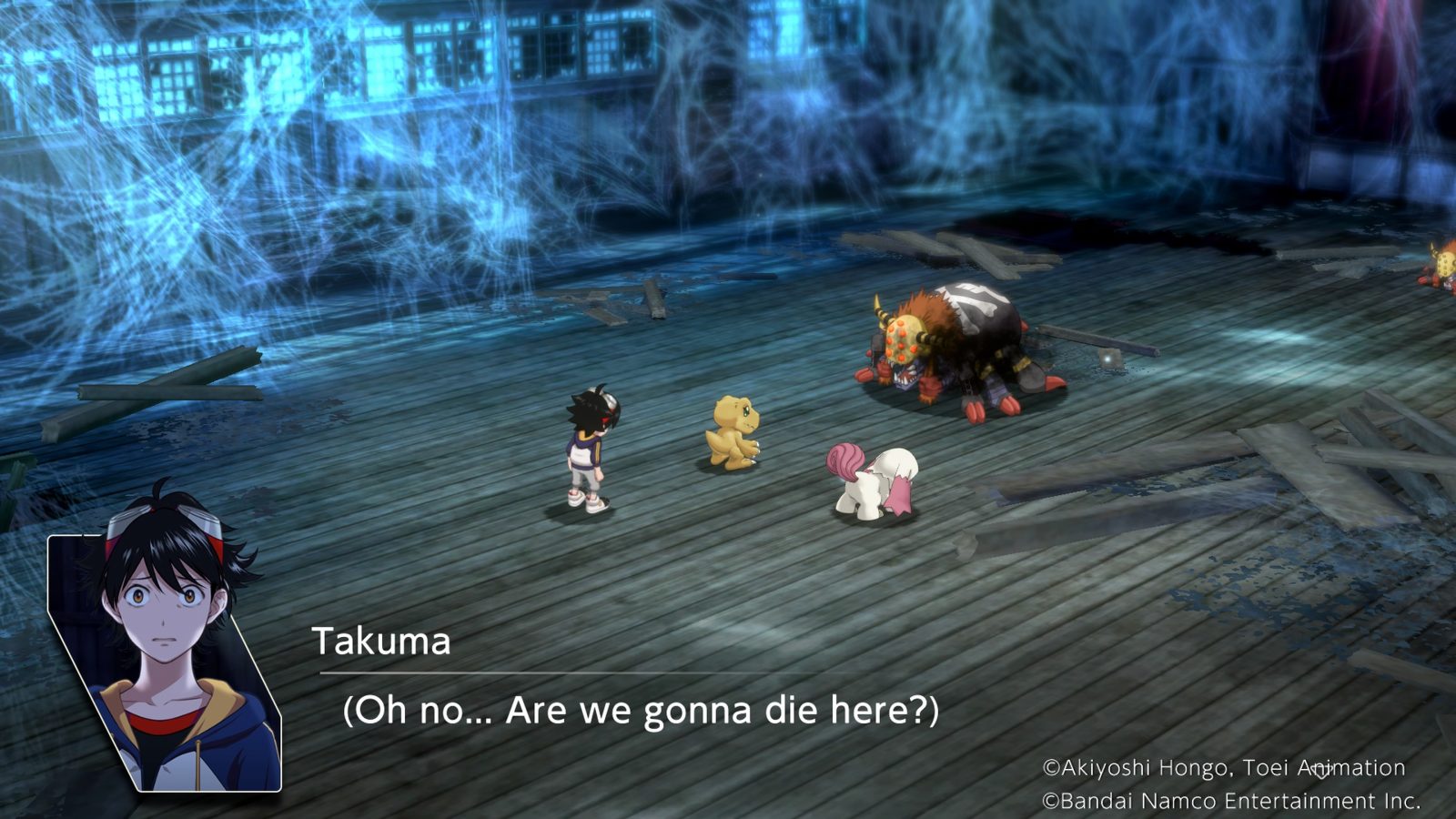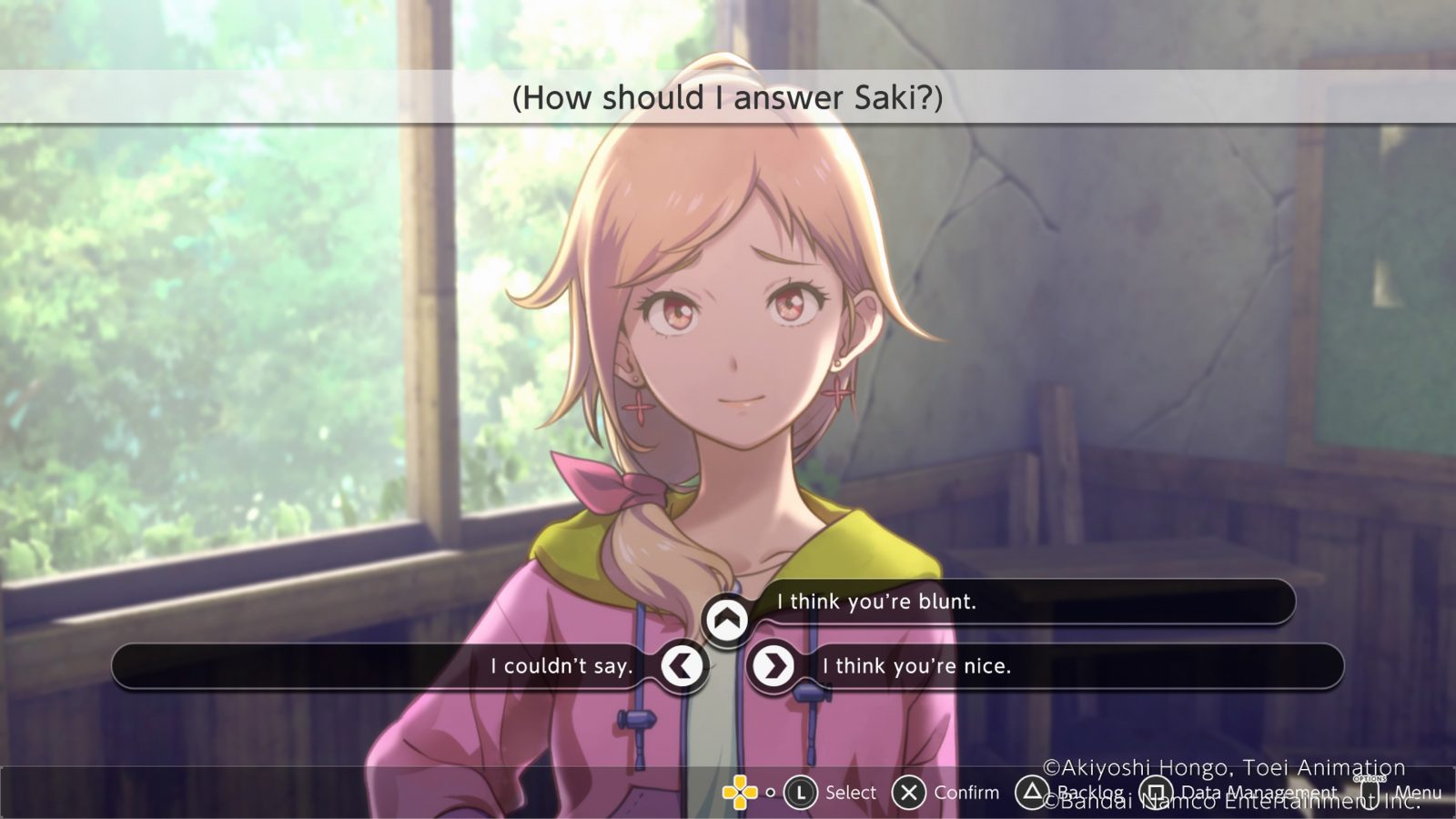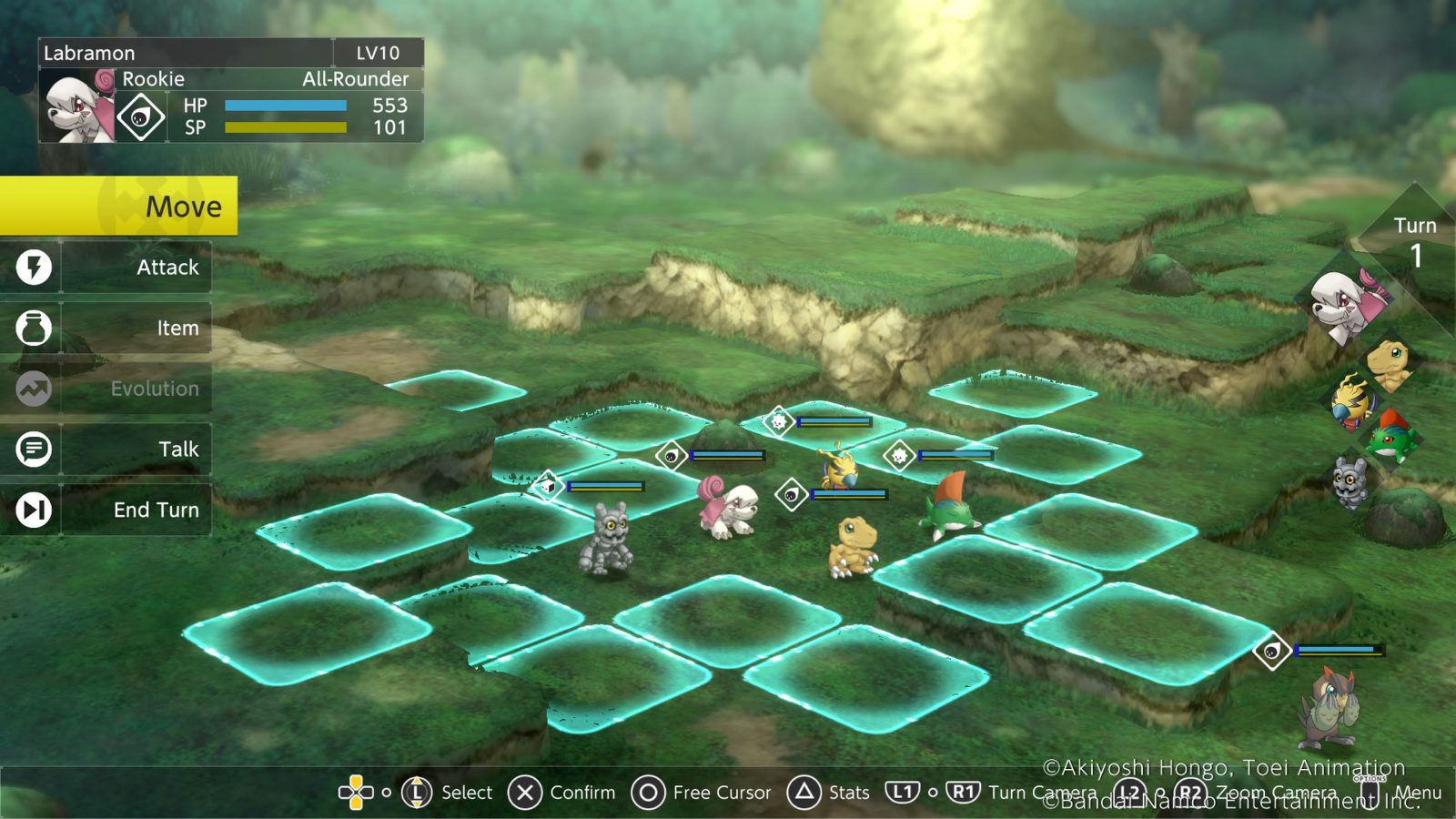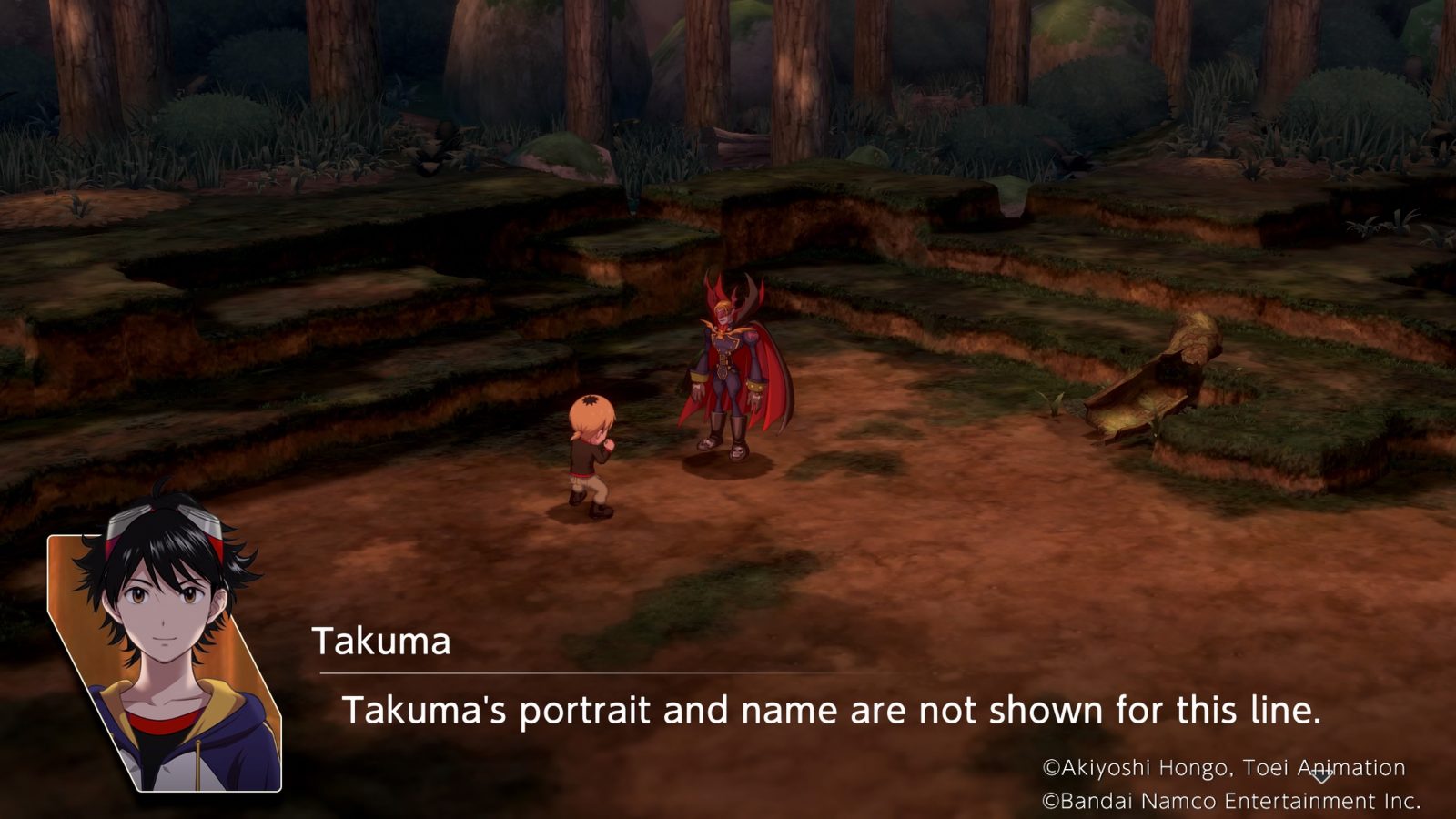
The word “survive” brings to mind the idea of a desperate struggle – the process of overcoming a life or death situation. You may have experienced something like that at some point, but I’d wager that most readers of Digimon video game reviews aren’t living through that kind of drama on a day-to-day basis. Make no mistake, though, you are still surviving. Everyone has their own struggles to overcome: whether you’re a kid, adult, or maybe even a Digimon. Carrying those burdens and adapting to them comes with the territory of surviving everyday life. Digimon Survive explores survival in both senses, connecting the fantastical scenario of Digimon with the more personal struggles that lie underneath.
I’m emphasizing the premise because that’s what Digimon Survive itself emphasizes. This game aims to convey the experience of survival primarily through its narrative. To that end, it assumes the form of a visual novel where you spend most of your time clicking through dialogue. Elements of strategy games, monster collecting, and time management are sprinkled throughout, but these elements exist more to enhance the narrative rather than overtake it. Digimon Survive contains a little bit of a lot of things, so it may be more accurate to describe it as a cohesive experience rather than any one genre.
Digimon makes sense as a vessel for this kind of experience. Storytelling is built into Digimon’s DNA, or at least the lines of code that Digimon are presumably made out of. Anyone familiar with the original Digimon Adventure cartoon will recognize the basics of Digimon Survive – a group of kids are suddenly warped into an unknown world where they meet Digimon, digital monsters if you will, that help them explore and stay alive in a world full of hostile creatures. On the surface, everything about that sounds cool: an unknown world to explore, a monster companion to raise, and enemies to defeat. That’s certainly one attitude you can have, and that’s the kind of narrative emphasized by the original show. Digimon Adventure was in fact an adventure.
That’s not the only way to look at that situation. Falling into an unfamiliar world, isolating from civilization, interacting with the local wildlife…this is pretty dangerous stuff! If you’re not careful, someone could die. Digimon Survive embraces that darker interpretation; it takes the familiar premise of the show and injects it with harsh reality.
Digimon Survive adopts a darker narrative tone, yet it’s not a hopeless one. Despite the visual novel angle, you’re more than just a passive observer in this tale. Hope can be found in the people and Digimon all around you, you just have to go out and find it. As you explore the outside world and interact with others, you steer the overall course the story takes.
The heart of Digimon Survives lies in its characters and your interactions with them – they ended up being my favorite aspect of the game. Your fellow Digimon survivors are an eclectic bundle of insecurities pushed to the limits of their patience and sanity. Some people cope just well enough to put on a brave face and get along, while others are visibly deteriorating and hostile.
By talking to people, you gradually accumulate relationship points for saying things they like, which grants you bonuses in battle and access to stronger versions of their Digimon. Growing your relationships depends on both how well you understand each person as well as who you actively make an effort to get to know. The game periodically locks you into “Free Time” segments that limit the amount of people you can speak to before the story progresses, forcing you to choose between who you want to spend time with.
What makes this process particularly interesting is that due to the mental strain they’re under, some of the characters you can form bonds are genuinely off-putting to interact with. They don’t grow or improve as the story progresses, they remain unpleasant to be around or even just observe from a distance. I spent a lot of time expecting them to undergo some dramatic character arc that totally changes their attitude, yet it never seemed to happen. Conflicts like this bring the struggle of survival to the forefront. Attempting to appeal to these more obstinate people feels like a fool’s errand, yet you can’t escape the nagging feeling that you really shouldn’t leave anyone behind, even if you might be better off without them.
Not all of your relationships are doomed, and even the ones that feel like they are still highlight an important aspect of the Digimon Survive experience. Everyone in the cast has their own hang-ups and struggles, and some people suffer more from them than others. Even if they weren’t trapped in a Digimon-themed deathtrap, they would still have problems in their day-to-day existence. By talking to them and sharing just a little bit in their struggles, you’re helping both that person and yourself survive on a literal and emotional level.
Surviving is a legitimate concern, as death looms over the cast. Some characters in the story will die; you get a taste of that fairly early into the game and the concept stays in the back of your mind long after. The presence of death not only sells the stakes of the survival narrative, it poisons your decision-making process. It may seem harmless to invest time and points into anyone you wanted early in the game, but knowing that they could pass away down the line makes any investments or emotional attachments feel like a risk.
Digimon Survive doesn’t just explore your bonds with people, it also explores your bonds with Digimon. In the show, Digimon always reflected their human counterparts to an extent. That’s why Digimon make such good partners, after all: they share your strengths and weaknesses. Digimon Survive makes these parallels especially obvious. In fact, it has an entire mechanic dedicated to the concept called karma. Karma determines both how your partner Digimon, Agumon, evolves as well as with the paths you can take as you progress in the game.
The choices you make for these karma points are less compelling than building up the character relationships. You’ll frequently be presented with one of three dialogue choices, which the game categorizes as Moral, Harmonious, or Wrathful. How exactly the dialogue choices correspond to each type of karma remains ambiguous to me even after multiple playthroughs, yet it also doesn’t matter much. Your karma choices do not affect how the story progresses on a moment-to-moment basis. They are purely about how you feel in the moment and the points you want.
Essentially, the visual novel portion of the game revolves around managing these metagame stats in between the main story beats. These stats incentivize you to roleplay and immerse yourself in the experience, which I can appreciate. However, they do run the risk of becoming just that: stats. The character writing maintains the illusion well enough to remain compelling. For the karma paths, stats are exactly what they became to me. Once you’ve made enough decisions aligning with a certain karma, there’s no real reason to diverge from it. If you’ve already evolved Agumon into a Greymon, it makes sense to just continue down that evolutionary path rather than try to swerve him into a different direction.
For the most part, what all these stat considerations really boil down to are bonuses for the battle sections of the game. The game spends a lot of time telling you how dangerous the characters’ situation is, so the battles are a chance to make the survival aspect of the game feel real on a mechanical level.
Battles lay out all of your Digimon on a grid, where they take turns moving and trading attacks – the standard format for strategy RPGs. Referring to these sections as “strategy” sections may be overselling things a bit. I don’t dislike these sections, it’s fun on a base level to crush enemies and watch the little attack animations, but your strategic considerations here are admittedly straightforward.
Virtually every battle boils down to defeating enemies on a map. That’s not necessarily a problem on its own. Your combat options are just limited to the point that there’s not much thinking involved to complete this objective. Each Digimon you control only has two attacks: a basic one and a stronger one tied to a limited pool of points. In most cases, your pool of points isn’t limited enough to deter you from just using the stronger attack whenever possible, though, so that element quickly takes a backseat. Positioning matters to an extent, as attacking an enemy from the side or back results in a damage bonus. Even this consideration eventually gets overridden, however, as your Digimon grow stronger and unlock more powerful evolutions which makes positioning irrelevant when you can just one-shot enemies from a distance.
Stats determine the results of battle far more than anything else. This became most apparent to me after I encountered a boss that was difficult less due to the boss itself and more due to the circumstances behind the battle. Normally, Digimon Survive gives you access to all of your fellow survivor’s Digimon. I had spent most of the game raising up those Digimon in addition to my Agumon, as sometimes you’re forced to use them anyway, so it just made sense to keep them in my constant rotation. At this particular point in the story, your access to those other Digimon has been cut off.
You do have other options to fall back on. Throughout the game, opportunities arise to recruit wild Digimon by negotiating with them. Unlike the humans in this game, these wild Digimon don’t make for especially great conversation partners and picking answers they like amounts to trial and error. Still, if you answer enough questions to their tastes, they will agree to tag along with you. I had recruited numerous wild Digimon up to reaching this particular roadblock boss; the problem was that I had barely used them in battle.
Basically, the boss could annihilate all of my weak wild Digimon in one blow, which left my Agumon as the one properly trained weapon in my arsenal. Unfortunately, my fodder Digimon simply couldn’t last long enough to provide effective support, which doomed Agumon as well. As strong as he was, he couldn’t withstand multiple boss attacks alone. No amount of retries or different maneuvers changed the result: I was stuck. The solution? I had to hit the Digi Gym and Digi grind.
To be clear, this was the only time I felt like I had to grind. Honestly, it was mostly my fault for neglecting the wild Digimon aspect of the game. If you’re going into battle with properly trained Digimon, you’ll never run into problems. This run-in was not a real hang-up for me, it just pinpointed the harsh truth about the battles: they are simple and the difficulty leans almost entirely on stats.
Still, I wouldn’t say the battles lack merit entirely. These sections shine light on the core themes of the Digimon Survive experience. As described in my boss battle mishap, you can’t get far by fighting completely alone. Having some kind of backup, even if just to sponge up some damage, makes a big difference. These bonds in the midst of battle are further expanded upon with mechanics like the relationship points, which provide access to bonuses like team-up attacks, or the talk mechanic, which lets one of your characters cheer the other on, granting special power-ups like increased damage or speed. As your relationships with your Digimon grow, they unlock new evolutions that boost their power dramatically. By working these different relationships into the battle mechanics, the battles work the core theme of supporting others to survive from the novel segments into a different yet equally potent angle.
The battles and the visual novel segments complement each other well, even if it’s not exactly an equal partnership. That may actually be for the best, given the simplicity of the battles. They are brisk enough to mix things up and engage you with the danger of the narrative without overstaying their welcome. Between the battles and the relationship building in the novel segments, Digimon Survive clearly instills its themes and ideas into the player, which is exactly what a narrative-focused experience should accomplish.
If anything drags down the narrative experience, it would unfortunately be the localization. This game did not receive the time and care required to do its writing full justice. Small typos alone would be one thing, with those you can at least tell what is happening. Digimon Survive’s localization problems run deeper than that. Dialogue that doesn’t match the character speaking, placeholder text, and even some misplaced lines that don’t seem to match the scenes at all are littered throughout the game. They come and go in waves and it never totally ruins the game, but it is disappointing to see. I get that localization isn’t always easy, I just think that the proper respect to the material should be given to ensure the job is done right, especially in a game as narrative-heavy as this one.
Digimon Survive
Great
Despite some translation woes, Digimon Survive’s narrative still shines brightly. As cruel and dark as its narrative can be, neither you or the characters should ever give up completely. That’s the key to survival, and that message is apparent in the character relationships, the battles, and the developments of the story as a whole. Digimon Survive expresses the power that can come from your bonds with others, and how supporting each other can keep hope alive. That’s a message worth sharing, and Digimon Survive is a messenger worth experiencing.
Pros
- Story and mechanics interweave to create an effective narrative experience
- Narrative explores familiar Digimon concepts and themes from a fresh angle
- Battles are simple fun that don’t bog down the game
Cons
- Stats matter more than strategy when it comes to difficulty spikes
- Localization did not get the care and attention it needed






